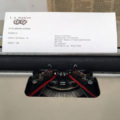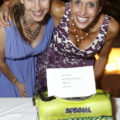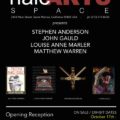LA Marler Teams Up with Steve Soboroff To Fund Journalism Scholarship
Santa Monica (June 2, 2014) – Louise “L.A.” Marler – Santa Monica artist, designer and SMC Community Education instructor – has teamed up with Steve Soboroff, a prominent L.A. civic leader and businessman, to create a stunning limited-edition series of prints featuring the typewriters of Orson Welles and Ray Bradbury.
A portion of the proceeds from the sale of the prints will be donated to a college or university journalism scholarship fund.
Marler – who creates images from original photography, graphics and illustrations – is a big fan of manual typewriters and photographed Welles’ and Bradbury’s personal typewriters in Soboroff’s famous authors typewriter collection. She then created the “Famous TypOwriters” series consisting, as she puts it, of “deep and richly detailed images to transform the photos into strong and inspirational homages.”
The Bradbury image features his 1947 Royal KMM, which was given to Bradbury’s documentary producer who traded it to Soboroff. Images from “Fahrenheit 451” and “Martian Chronicles” are collaged to create a blazing monument of his writing machine that is a visual story. “In the spirit of the writer, this artwork embodies Bradbury’s far-out and passionate intellect,” Marler said.
The Welles’ limited-edition piece highlights his Underwood 4-Bank, a portable from 1926. This red faux wood-grain machine, which includes his original signature, was acquired from the 1989 Estate Sale of Welles. The repetition of “FAKE!” in the background is a reference to the filmmaker’s last major movie, “F for Fake.”
“’F for Fake’ was a brave statement about the (mis)perceptions of the art world that inspired me even more than “’Citizen Kane,’” Marler said. “I incorporated a photographed frame from the film for the background pattern and a simple, surreal 1950s hat. It’s dark and mysterious. In keeping with the film, this artwork has a visual trick included.”
Marler – whose Santa Monica Airport studio is a shrine to the art and power of print in its variety of forms, and most particularly to manual typewriters dating back more than a century – met Soboroff recently because they were both featured in a documentary about the old-fashioned typewriting machines.
Soboroff, current President of the Los Angeles Police Commission and Chairman of the Board of the Weingart Foundation, is an avid collector of typewriters, including ones used by Tennessee Williams, George Bernard Shaw, Ernest Hemingway and John Lennon.
“Collecting typewriters with interesting histories is one of my favorite past-times,” Soboroff said. “Allowing Ms. Marler to expand her TypOwriter Artwork is a great way to share this interesting part of history with the community.” Soboroff gave permission to Marler to photograph the two famous authors’ typewriters on the condition that a portion of the sales of the limited-edition prints goes to a journalism scholarship. “Mr. Soboroff’s request to fund a journalism scholarship with a portion of the sales gives me a great additional purpose with this project,” said Marler, who is in the process of finding the best recipient school for the scholarship. “Having a great respect for and appreciation of journalists, as well as concern for the future of global news, I am delighted to give back.”
Marler’s infatuation with the typewriter dates back to her youth in St. Louis, Mo., but it wasn’t until a few years ago that she channeled that affection into her art. And the fruits of that romance have been bountiful – large format to small fine art gallery exhibits and merchandise to “Type-Ins” to her newest project, Famous TypOwriters.
Marler – who has been teaching printmaking at SMC Community Education – will be offering, for the first time, three printmaking summer camps for youth. “Teaching gives me an opportunity to share my knowledge and techniques,” she said. “It’s great to share and see how people put things together for themselves.” As for teaching young people, she says, “I feel, potentially, printing could become a lost art, and I want the next generation to experience something tactile and to see the results of what they are producing.”
It’s no surprise that Marler has such a deep connection to print and typewriters. Her grandfather was a typewriter repairman and her father the owner of an office equipment store. And from her mother, a home economics teacher, she inherited a love for fashion that she combined with printmaking when developing a successful print-on-demand T-shirt line.
But it wasn’t until about five years ago when visiting her parents and looking for a new project that she rediscovered her father’s treasure trove of old typewriters.
“My dad would take trade-ins so the more interesting machines collected in our home and now my parents have a barn-full of them,” she said.
Inspired by flat color, with the manufactured simplicity of advertising and pop art, Marler takes photos of typewriters and manipulates them digitally to create bold images with simple text. The most popular of her limited edition prints features a red typewriter with yellow keys, above which simply says “Word.”
Other images – some featuring machines that date back as far as 1896 – have such inspiring text as “Keys to Success” and “What’s Your Story?” Others are sassy puns, including “Bang it, Sexy!” and “Talk QWERTY to me.” Still others are simple graphics dominated by text but with individual letters arranged to look like they are on old typewriter keys, such as “You are my type.” (All of these are copyrighted.)
Marler didn’t start out to be a print-maker. She graduated from Southeast Missouri State University with a business degree – which has since come in handy as an artist who is also running a commercial enterprise – and got her first job with the St. Louis Globe-Democrat “because I was intrigued by the reality of a huge press on the premises as well as the flow of information. I have been in love with ink and paper since the beginning of when I got to know it at the newspaper,” she said.
Later, she moved to Los Angeles and did marketing for a printer. In 1991 she started taking graphic design and creative writing courses at Santa Monica College and started creating logos and other graphics for various clients.
In the mid-1990s she bought a printing company in Santa Monica, and business was brisk in the economic boom. She sold her half of the company in the late 1990s and started her fine art publishing venture.
Her artwork has touched on themes other than typewriters – for example, she recently created “HI Infinity,” a Maui surrealism series of all original photographs digitally collaged, which are showing at Tranquility, a salon in Santa Monica. “My subjects of interest toggle between nature and industry,” she notes with a smile.
But it’s the world of words that has dominated her process and her success. Her “TypOwriter” series has led to community Type-Ins, including one at Beyond Baroque; an exhibit at the beautiful Rancho Mirage Library in conjunction with its first writer’s conference and the library’s purchase of four of her prints for its permanent collection; and her being featured in the documentary, “The Typewriter (In the 21st Century).
Marler says her creations are a unique blend of past function with modern form. “It’s been a great adventure to combine my calling to visually communicate through print, writing, technology and now film,” she said. “My ‘Famous TypOwriters’ series bridges these art forms and will help support the next generation.
For more information about the “Famous TypOwriters” series of prints, which range in price from $900 to $1,800 when purchased directly from the artist, contact Marler at LAMarler@mac.com or (310) 204-0452.
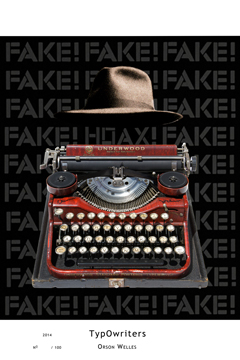
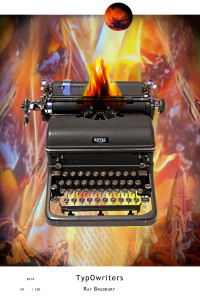
Caption information for photos: Marler teamed up with Steve Soboroff to create stunning prints of Orson Welles’ and Ray Bradbury’s typewriters. Part of the proceeds from the sale of the prints will go to a college or university journalism scholarship.

